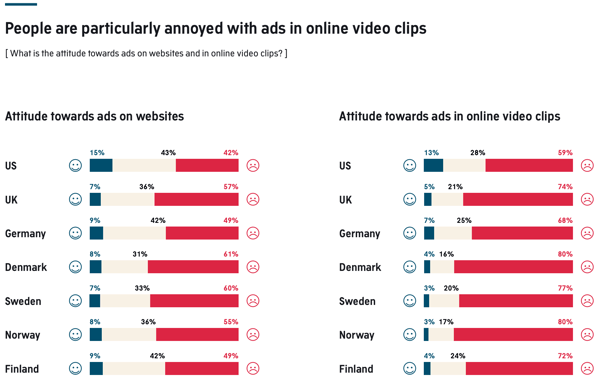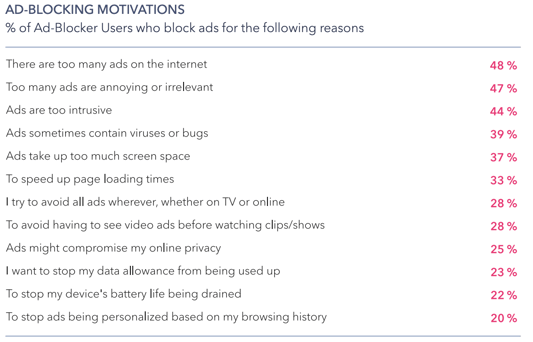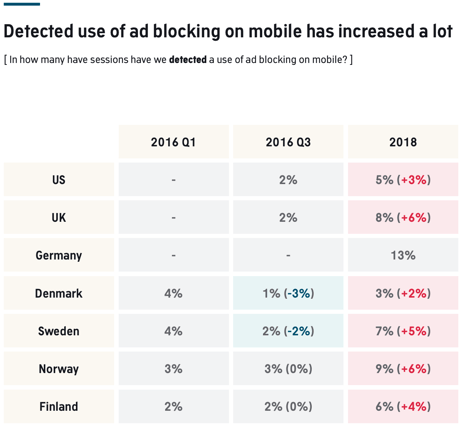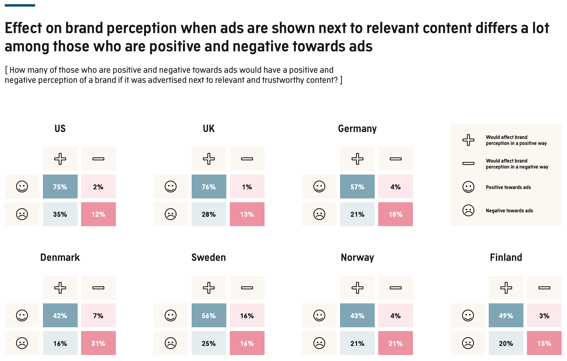Ad Blocking Goes Mainstream
The digital advertising industry is facing immense changes, with audiences that are less tolerable of online advertising, ad blocking is on track to greatly reduce their reach and impact.
- In a study carried out by the Audience Project, consisting of more than 16,000 participants from Germany, the UK, the US and the Nordics, they investigated consumers attitudes towards ad blocking.
- Across all the countries included in the survey, the results showed that 60% of participants used an ad blocker in some form and on at least one device.
- On the whole, the survey suggests that consumers attitudes towards advertising generally continues to be negative, with ad blocking on the rise.
Getting consumers to engage with advertising is a problem that marketers are faced with daily. Consumers understand ads are a necessary burden that usually comes when viewing free content online, but with the current interruptive and intrusive state of digital advertising, consumers are far from happy.
The way in which marketers respond to the increase in ad blocking will mould the industry and user experience for the future. This study shows that not all of the participants have a negative perception towards ads, and given the right context and relevance, even those with negative feelings towards ads claimed their brand perception could be positively influenced.
Motivations behind ad blocking:
In a survey carried out by Global Web Index, they investigated key age groups and their lead motivator to use ad blocking.
- 16-24 did not want to watch an ad before a clip or TV show.
- 25-34 wanted to prevent data allowance being used.
- 35-44 wanted to stop their battery life being drained.
- 45-54 and 55-64 did not want personalised ads on their browsing history.
Mobile Only:
For the most part, ad blocking was more common on computers, but now ad blocking on mobile is increasing, with detected use of ad blocking on mobile rising from 2% to 8% in 2016 and 2018 respectively. Out of the countries included in the survey, Germany comes out first with 13% of participants using detected ad blockers on their mobiles.
As mentioned previously, 47% of ads are ‘too annoying or irrelevant’ to the consumer, they are unable to find a connection to them that would encourage them to engage. Instead, the ads are simply causing disruption to their online experience.
In an article by CLICKON Social Lab’s, ‘It’s Not A Mobile First World, It’s A Mobile Only World’, results highlighted that in order for brands to stay in the eye of the consumer, they must prioritise optimising content for mobile. Mobile is now omnipresent, it is quite literally always within a consumer’s reach, with 16% of 18-24 year-olds stating they are mobile only, this figure doubles at 35-44 and continues to increase as age increases.
With consumers reliance on ad blockers for mobile increasing, marketers are facing another challenge, as in this state of digital marketing, mobile is the easiest medium to reach consumers.
User Experience:

The context in which an ad is placed is surprisingly not the leading issue causing a consumers negative perception of brands. The survey makes evident that the cause lies predominantly with the irrelevance of an ad. Out of UK participants, 57% and 74% have a negative attitude towards ads on websites and in online video clips respectively (for example YouTube) .
The main reason for this is because the user’s online experience is disrupted, and often with ads that are not relevant to them.
Ads are interrupting:
As indicated in the chart above, when participants were asked if the placement of an ad with relevant content would improve or worsen their brand perception, on the whole, both participants of positive and negative perceptions towards ads, stated that this would improve their brand perception in a positive way.
What marketers can draw from this is that focus needs to be concentrated on improving the general ad experience, as well as providing high-quality content that invites their consumers to engage not block.
With consumers overwhelmed by the volume of ads they are exposed to, it comes as no surprise that they want to block out the majority of them. In a survey conducted by Global Web Index, they found that 44% of participants said ads were too intrusive.
In response to this, Richard Wilson, CEO and Co-Founder at CLICKON Media states,
“brands need to add to conversations and tell honest human stories that engage and inform, not continually interrupt.”
The way marketers choose to respond to ad blocking will now shape the future of the industry and the experience users have online. This study indicates that a lot of the participants would be willing to look at the ads if they were relevant, less intrusive, and shared within the correct context. The main takeaway point is that consumer behaviour should guide the marketing strategy, if marketers can implement this, the future of digital advertising will look a lot brighter.



